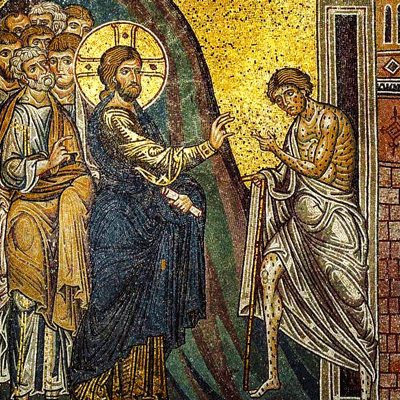 A leper came to Jesus and pleaded on his knees: ‘If you want to, you can cure me.’ Feeling sorry for him, Jesus stretched out his hand, touched him. ‘Of course I want to!’ he said. ‘Be cured.’ And the leprosy left him at once and he was cured. Jesus immediately sent him away and ordered him, ‘Mind you say nothing to anyone, but go and show yourself to the priest, and make the offering for your healing prescribed by Moses as evidence of your recovery.’ The man went away, but then started talking about it freely and telling the story everywhere, so that Jesus could no longer go openly into any town, but had to stay outside in places where nobody lived. Even so, people from all around would come to him. (Mark 1:40-45)
A leper came to Jesus and pleaded on his knees: ‘If you want to, you can cure me.’ Feeling sorry for him, Jesus stretched out his hand, touched him. ‘Of course I want to!’ he said. ‘Be cured.’ And the leprosy left him at once and he was cured. Jesus immediately sent him away and ordered him, ‘Mind you say nothing to anyone, but go and show yourself to the priest, and make the offering for your healing prescribed by Moses as evidence of your recovery.’ The man went away, but then started talking about it freely and telling the story everywhere, so that Jesus could no longer go openly into any town, but had to stay outside in places where nobody lived. Even so, people from all around would come to him. (Mark 1:40-45)
In Biblical times people with any kind of shiny, scaly skin condition were usually considered to have leprosy. This is not Hansen’s Disease - the proper name for leprosy as we know it today.
Anyone suspected of being leprous had to live outside their town for fear of spreading the disease to others. They had to leave their home and family, their job, their community and their synagogue. They were dependent on others to bring them food and water.
This sense of fear and suspicion about lepers is a stark contrast to the welcome given by Jesus to the man in the Gospel today.
He comes to Jesus and asks him to make him clean, to cure him. Jesus is deeply moved and touches the man (which must have required great compassion) and cures him. In healing the man, Jesus has done much more for him than simply relieving him of a distressing ailment. Jesus has literally given the man his life back. Now he can go home to his family, take up his job again and renew his religious practice in the synagogue.
In Jesus’ day many people took illness, disease and disability as a sign that people were also morally ill, that they had sinned, done something wrong. By healing the sick, Jesus removes the taint of evil from them as well.
Interestingly, there is a kind of ‘role-reversal’ in this Gospel. In the beginning it is the leper who is the outcast, the one who must live outside the town. Because the cured man tells the story everywhere, Jesus now becomes the one who has to stay outside the towns and villages. Never the less, the people, like the leper, still come to him for healing.
Are there lepers in our own lives, too? Can we do something to bring them back into our lives and/or into the lives of others, too?
Aware of our need for healing, we, too, can take the initiative by approaching Jesus. We will be met with welcome, compassion and love. We can be restored to our rightful place as beloved sons and daughters. We, too, can tell the story of what God has done for us.
Download our Celebrating At Home liturgy for this Sunday here:
Celebrating At Home - 6th Sunday of Ordinary Time B [PDF]
Celebrating At Home - 6th Sunday of Ordinary Time B [ePub]